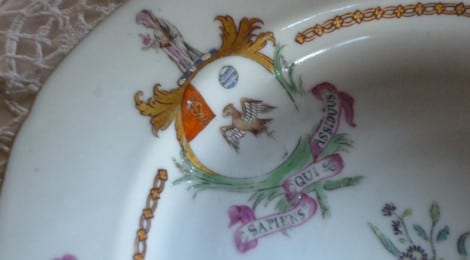
New Case Study: Armorial Porcelain
Chinese porcelain services specially commissioned by individuals and families to include their coats of arms within the decorative scheme were distinctly fashionable and popular in eighteenth-century Britain, particularly among those with East India Company connections. Armorial porcelain services feature in various East India Company at Home case studies, including Osterley Park and House, Valentines Mansion and Gardens and the Shugborough Estate. Written by Research Fellow Kate Smith ‘Manly objects? Gendering Armorial Porcelain Wares’ takes a closer look at the Basildon Park armorial porcelain service to question the identity politics embedded in porcelain pieces decorated with coats of arms. It considers how family names were displayed and bolstered as a result of owning dinner plates bearing a particular coat of arms. It also asks whether the plates, dishes and sauceboats that made up lavish armorial dinner services actively shaped other identities. Principally, it asks, were armorial services gendered? If so, how, and why? While many scholars have explored the relationship between women and porcelain in the eighteenth century, Kate suggests that armorial porcelain wares allow us to consider the relationships that contemporaries conceived as existing between men and this highly prized translucent material. In exploring these questions, this case study investigates the place Chinese porcelain held within British culture and the ways in which British citizens used Chinese porcelain to perform specific cultural work.
To read the case study, click here.
‘Manly Objects? Gendering Armorial Porcelain Wares’ also contains an audio recording of Neil Shaw (House Steward, Basildon Park, National Trust) and Sir John Sykes (descendent of Sir Francis Sykes of Basildon Park) discussing how the Basildon service returned to the house in the 1980s. To go directly to this recording, click here.


Recent posts